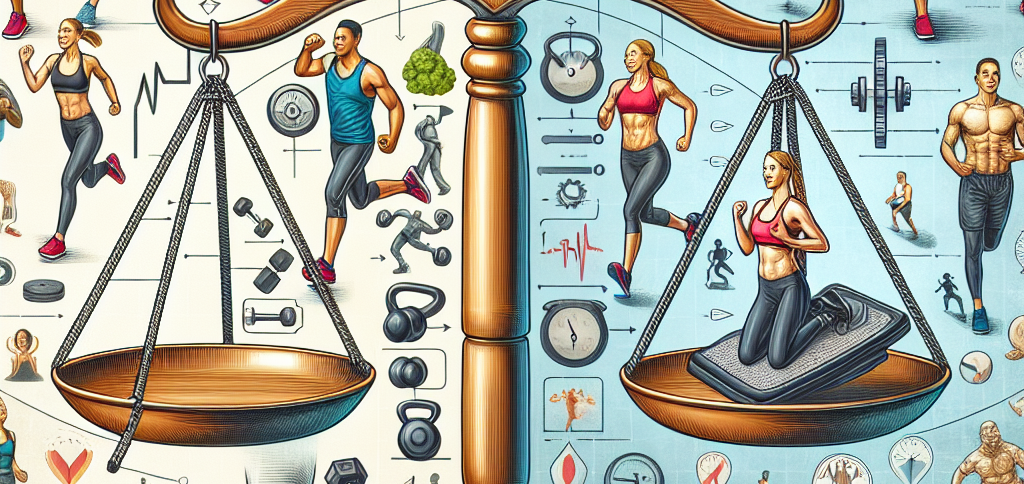When it comes to fat loss, two primary types of exercise are often touted as kings: cardio and strength training. For many, the question of which method is superior can be confusing. In this article, we’ll break down the pros and cons of both disciplines in a listicle format, helping you make an informed decision about which approach suits your goals best.
1. Understanding Fat Loss
Before we dive into the nuances of cardio versus strength training, it’s essential to understand the fundamentals of fat loss. At its core, fat loss occurs when you consume fewer calories than you burn, creating a caloric deficit. Both cardio and strength training can help you achieve this, but they do so in different ways.
2. Cardio: The Calorie-Torcher
Pros:
-
Burns Calories Quickly: Cardio exercises, such as running, cycling, or swimming, tend to burn more calories in a shorter period compared to strength workouts. This is great for those looking for a quick calorie burn.
-
Easy to Get Started: Most cardio exercises require minimal equipment. A good pair of running shoes or a bike is often all you need.
- Heart Health: Cardio is excellent for improving cardiovascular health, enhancing lung capacity, and boosting overall endurance.
Cons:
-
Muscle Loss: Excessive cardio without strength training may lead to muscle loss, which can be counterproductive for long-term fat loss. Muscle tissue is metabolically active, meaning it burns more calories at rest.
- Plateaus in Fat Loss: Your body can adapt to a cardio routine, leading to diminishing returns over time. This plateau can make sustained fat loss more challenging without changing your routine.
3. Strength Training: The Muscle-Building Machine
Pros:
-
Increases Muscle Mass: Strength training increases lean muscle mass, which can help boost your metabolism. More muscle means you burn more calories even at rest, enhancing your fat-burning potential.
-
Long-Term Fat Loss: Research indicates that strength training can lead to greater fat loss over time. As you build muscle, your body burns more calories even when you’re not exercising.
- Improves Bone Density: Weight training promotes stronger bones, reducing the risk of osteoporosis and other bone-related issues as you age.
Cons:
-
Calorie Burn During Workout: While strength training can burn calories, it typically doesn’t burn as many calories per session compared to a vigorous cardio workout.
- Learning Curve: Proper technique is crucial in strength training to prevent injury. Beginners might need guidance to learn the correct form.
4. Combining Cardio and Strength Training
The Best of Both Worlds
Rather than viewing cardio and strength training as mutually exclusive, consider adopting a hybrid approach. Incorporating both types of exercise can provide a balanced routine that maximizes fat loss and overall fitness.
Here’s How to Combine Them:
-
Alternate Days: Schedule strength training sessions three times a week and reserve the other days for cardio workouts.
-
Circuit Training: This involves performing a series of strength exercises back-to-back with minimal rest, which can keep your heart rate elevated while building muscle.
- Add Cardio to Strength Sessions: Incorporate short bursts of cardio, such as jumping jacks or running in place, between your strength exercises to elevate your heart rate and increase calorie burn.
5. The Importance of Nutrition
Regardless of whether you choose cardio, strength training, or both, nutrition plays a critical role in fat loss. A well-balanced diet rich in whole foods, lean protein, healthy fats, and complex carbohydrates is essential for supporting your exercise routine and maximizing results.
For those looking for structured guidance, learning more about effective fat loss strategies can help optimize your efforts. Click Here to learn more.
6. Individual Preferences and Goals
Ultimately, the best exercise for fat loss depends on your personal preferences and goals. Here are some questions to help guide your decision:
-
What Do You Enjoy?: If you love running or dancing, cardio might be your go-to. If you prefer lifting weights, then strength training is likely more enjoyable.
-
What Are Your Goals?: If your primary goal is to lose weight quickly, a focus on cardio may be effective. If you’re looking to build muscle and improve metabolism, strength training is key.
- How Much Time Can You Dedicate?: Consider your schedule. If you have limited time, perhaps a quick high-intensity interval training (HIIT) session combining both modalities is the answer.
7. Conclusion: Personalization is Key
There isn’t a one-size-fits-all answer to the cardio versus strength training debate for fat loss. Both have their unique advantages and can play a vital role in your fitness journey. The most successful fat loss programs often include a combination of both cardio and strength training, tailored to your preferences and lifestyle.
Keep in mind that consistency, nutrition, and listening to your body are all critical components of a successful fat loss strategy. No matter which method you choose, remember to set realistic goals and celebrate your progress along the way. With the right approach, you can achieve your fat loss goals and develop a healthier, stronger body for years to come.
By arming yourself with the right information and support, you can make informed choices that align with your unique fitness journey. Explore various methods, experiment with different routines, and find what works best for you to turn your fat loss aspirations into reality.






